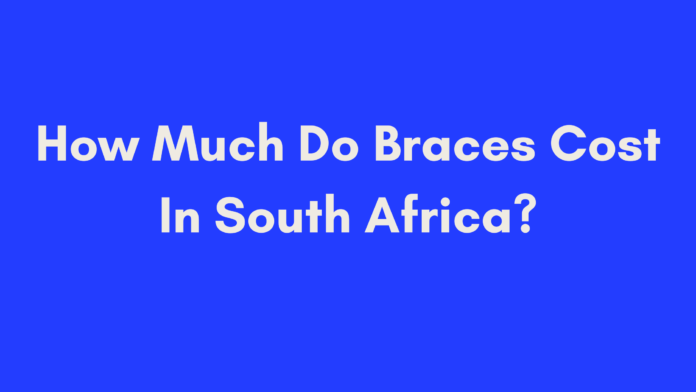Quick Summary
If you’re considering braces in South Africa, understanding the costs and factors involved is crucial. On average, braces can cost between R18,000 and R42,000, depending on the type of braces and the duration of treatment. The initial comprehensive examination typically costs around R4,950, while the first consultation is approximately R1,200. Costs vary by the type of braces—metal, ceramic, lingual, Invisalign, or self-ligating—and by location. Insurance coverage and government options may help reduce expenses, and many orthodontists offer payment plans to make treatment more affordable. This guide will provide a detailed look at these costs and other essential factors to help you make an informed decision.
Introduction to Braces and Their Costs
Braces are more than just metal brackets and wires; they’re a pathway to a healthier, straighter smile. Whether you’re an adult considering treatment or a parent looking into options for your child, understanding the cost of braces in South Africa is crucial. In this section, we’ll explore what braces are, the different types available, and their associated costs.
What Are Braces?
Braces are orthodontic devices used to correct misaligned teeth and jaws. They work by applying continuous pressure over time to gradually move teeth into their proper positions. Here’s a quick overview of how braces work:
- Brackets: Small squares bonded to the teeth.
- Archwire: A thin metal wire that runs through the brackets.
- Elastic Bands: Often used to apply additional pressure.
Braces are typically recommended to correct issues such as overcrowding, gaps, underbites, overbites, and crossbites. They can also improve oral health by making it easier to clean your teeth and reducing the risk of gum disease and tooth decay.
Average Cost of Braces in South Africa
The cost of braces can vary significantly based on several factors, including the type of braces, the length of treatment, and the location of the orthodontist’s practice. Here’s a breakdown of average costs:
- Comprehensive Examination: Approximately R4950. This initial assessment includes diagnostic procedures like x-rays and intraoral scans.
- First Consultation: Around R1200. This visit allows you to discuss your treatment options and get an expert opinion.
- Braces or Aligners: Costs vary widely depending on the type:
- Metal Braces: About R25,000.
- Lingual Braces: Around R42,000. These are placed behind the teeth and are less visible.
- Invisalign: Also around R25,000. These clear aligners are a discreet alternative to traditional braces.
- Ceramic Braces: Similar to metal braces in cost, approximately R25,000. They blend with the color of your teeth.
- Self-Ligating Braces: Typically starting from R18,000. These use clips instead of elastic bands, which can make adjustments easier.

Factors Influencing the Cost of Braces in South Africa
Several factors can impact the cost of braces. Understanding these can help you plan your budget and make an informed decision.
Type of Braces
The type of braces you choose is one of the biggest factors affecting the cost. Here’s a quick comparison:
- Traditional Metal Braces: The most common and usually the least expensive option. They are effective but less discreet.
- Lingual Braces: Positioned behind the teeth, making them less noticeable but more expensive due to customization.
- Invisalign: Clear aligners that are removable and nearly invisible but come at a higher price.
- Ceramic Braces: Designed to blend with the color of your teeth, offering a more aesthetic option than metal braces.
- Self-Ligating Braces: Use a different mechanism for holding the archwire, which may reduce overall treatment time and cost.
Length of Treatment
The duration of your treatment can also affect the total cost. Generally, braces are worn for about 18 to 36 months. The complexity of your case will determine how long you need to wear them. More severe alignment issues may require longer treatment times.
Location of the Orthodontist’s Practice
Where you choose to get your braces can impact the cost. Orthodontists in major cities like Johannesburg or Cape Town may charge more due to higher overhead costs, including rent and salaries. On the other hand, practices in smaller towns or rural areas might offer more affordable options.
Additional Costs
Remember that the cost of braces doesn’t just include the initial price. You’ll also need to account for:
- Regular Adjustments: These visits ensure your braces are working correctly and may involve additional costs.
- Retainers: After braces are removed, retainers help maintain the new position of your teeth.
- Dental Hygiene: Good oral care is essential to avoid issues during treatment.
By considering these factors, you can better understand the financial commitment involved in getting braces and make a more informed decision about your orthodontic care.
Average Costs of Braces in South Africa
Understanding the average costs associated with braces in South Africa can help you make an informed decision. Here’s a detailed breakdown of what you can expect to pay based on the type of braces and additional factors.
Breakdown of Costs by Braces Type
- Metal Braces
- Average Cost: R25,000
- Details: Metal braces are the most traditional and commonly used. They consist of metal brackets and wires and are effective for treating most orthodontic issues. While they are the most visible, they are often the least expensive option.
- Lingual Braces
- Average Cost: R42,000
- Details: Lingual braces are attached to the back of the teeth, making them less noticeable. They are customized for each patient and are generally more expensive due to their complexity and the need for specialized equipment.
- Invisalign
- Average Cost: R25,000
- Details: Invisalign consists of clear, removable aligners that gradually shift teeth into place. They are popular for their discretion and convenience but come at a higher cost. Regular visits are required to monitor progress and receive new aligners.
- Ceramic Braces
- Average Cost: R25,000
- Details: Ceramic braces use clear or tooth-colored brackets to blend with the natural color of your teeth. They offer a more aesthetic option compared to metal braces but are similar in cost.
- Self-Ligating Braces
- Average Cost: R18,000
- Details: These braces use a sliding mechanism instead of elastic bands to hold the wire in place. They can reduce the number of adjustments needed and may shorten treatment time, potentially reducing overall costs.
Additional Costs to Consider
- Initial Consultation and Examination
- Average Cost: R1,200 – R4,950
- Details: This includes a comprehensive assessment, x-rays, and initial diagnostic tests.
- Regular Adjustments
- Average Cost: R500 – R1,000 per visit
- Details: Adjustments are needed to ensure that the braces are working correctly and to make necessary modifications.
- Retainers
- Average Cost: R1,500 – R3,000
- Details: After braces are removed, retainers help maintain the new position of your teeth. They are essential for preventing teeth from shifting back.
- Emergency Repairs
- Average Cost: R500 – R2,000
- Details: If a bracket or wire breaks, additional costs may be incurred for repairs.
Factors Affecting the Cost
- Complexity of Treatment: More complex cases may require additional time and resources, increasing the overall cost.
- Orthodontist’s Location: Prices can vary depending on the city or region due to differences in cost of living and practice overhead.
Insurance Coverage and Government Hospital Options
Navigating the financial aspects of orthodontic care can be challenging, but understanding your options for insurance coverage and government assistance can help manage the costs.
Private Health Insurance
Many private health insurance plans in South Africa offer coverage for orthodontic treatment, though the extent of coverage can vary. Here’s what to look for:
- Policy Coverage: Review your policy to understand what is covered. Some plans may cover a portion of the cost for braces, while others may offer limited benefits.
- Out-of-Pocket Costs: Even with insurance, you may need to cover a portion of the costs yourself, including any co-payments or deductibles.
Government Hospitals and Clinics
Government hospitals and clinics in South Africa may offer orthodontic services at reduced costs or even free, but there are some considerations:
- Availability: Services may be limited, and there could be long waiting times due to high demand.
- Eligibility: Some government facilities may have specific eligibility criteria based on age, income, or medical need.
Financial Assistance and Payment Plans
Many orthodontic practices offer payment plans to make treatment more affordable:
- Installment Plans: Spread the cost of braces over several months or years.
- Financing Options: Some practices partner with financial institutions to offer low-interest loans for orthodontic treatment.
Tips for Managing Costs
- Shop Around: Get quotes from multiple orthodontists to compare prices.
- Ask About Discounts: Some practices offer discounts for paying upfront or for multiple family members.
- Check with Your Insurance Provider: Confirm what your insurance plan covers and how much you will need to pay out of pocket.
By exploring these options, you can better manage the financial aspects of getting braces and make informed decisions about your orthodontic care.
Best Age to Start Braces Treatment
Determining the ideal age to start braces treatment is crucial for achieving the best results. While there’s no one-size-fits-all answer, various factors can help guide your decision.
Ideal Age for Children
- Early Intervention
- Recommended Age: 7-10 years
- Details: The American Association of Orthodontists suggests that children should have their first orthodontic evaluation by age 7. Early intervention can address issues like overcrowding, crossbites, and bite problems before they become more severe. Early treatment often involves space maintainers or expanders rather than full braces.
- Benefits of Early Treatment
- Details: Early intervention can guide the growth of the jaw and align teeth, potentially reducing the need for more extensive treatment later on. It can also improve self-esteem by addressing visible dental issues early.
Ideal Age for Teenagers
- Adolescence
- Recommended Age: 11-15 years
- Details: This is a common age range for full braces treatment. By this age, most children have a mix of adult and permanent teeth, making it easier to correct alignment issues. Braces are effective during this period because the jaw and teeth are still growing, allowing for more precise adjustments.
- Benefits for Teenagers
- Details: Treating orthodontic issues during adolescence can help achieve a straighter smile before entering adulthood. It also aligns with the natural growth phase, making adjustments and treatments more effective.
Ideal Age for Adults
- Late Adolescence and Adulthood
- Recommended Age: 16 years and older
- Details: While braces are commonly associated with children and teenagers, adults can also benefit from orthodontic treatment. Advances in orthodontic technology, such as clear aligners, have made it easier for adults to undergo treatment without the aesthetic concerns of traditional braces.
- Benefits for Adults
- Details: Adult orthodontic treatment can correct long-standing dental issues, improve oral health, and enhance self-confidence. It can be part of a broader dental care plan, including addressing issues like TMJ disorders or bite problems.
Factors Influencing the Best Age
- Dental Development: The timing of braces treatment should align with the stage of dental development. Early evaluations help determine the right time to start based on individual needs.
- Orthodontic Needs: Some issues require early intervention, while others can wait until the majority of permanent teeth have erupted.
- Personal Readiness: Consider the patient’s readiness for braces, including their ability to maintain oral hygiene and adhere to treatment requirements.
Duration of Braces Treatment
The length of time you’ll need to wear braces depends on various factors, including the complexity of your dental issues and the type of braces you choose. Here’s an overview of what to expect:
Average Treatment Time
- Metal Braces
- Average Duration: 18-24 months
- Details: Metal braces are effective for most orthodontic issues, and treatment duration can vary based on the severity of the case.
- Lingual Braces
- Average Duration: 24-36 months
- Details: Lingual braces may take longer to achieve results due to their position behind the teeth and the need for precise adjustments.
- Invisalign
- Average Duration: 12-18 months
- Details: Invisalign treatment time can be shorter than traditional braces, but it depends on the complexity of the dental issues being addressed and patient compliance.
- Ceramic Braces
- Average Duration: 18-24 months
- Details: Ceramic braces offer similar treatment durations to metal braces, with the added benefit of being less visible.
- Self-Ligating Braces
- Average Duration: 12-18 months
- Details: These braces can reduce the overall treatment time due to their efficient mechanism and fewer adjustments.
Factors Affecting Treatment Duration
- Complexity of the Case
- Details: More severe orthodontic issues may require longer treatment times to achieve the desired results.
- Patient Compliance
- Details: Following the orthodontist’s instructions, such as wearing rubber bands or aligners as directed, can influence the duration of treatment.
- Type of Braces
- Details: Different types of braces may have varying treatment times based on their design and effectiveness.
- Age and Growth
- Details: For younger patients, growth spurts can impact the treatment duration, as their jaws and teeth are still developing.
Managing Your Expectations
- Regular Adjustments: Frequent visits to the orthodontist are essential for monitoring progress and making necessary adjustments.
- Patience: Orthodontic treatment is a process that requires patience and commitment. Maintaining good oral hygiene and following care instructions can help ensure successful results.
Payment Options and Financing Plans
Affording orthodontic treatment is a significant concern for many families and individuals. Understanding the available payment options and financing plans can ease the financial burden.
Payment Options
- Out-of-Pocket Payments
- Details: Paying for braces upfront or in full can sometimes lead to discounts. This option requires significant immediate financial resources but may offer cost savings in the long run.
- Payment Plans
- Details: Many orthodontic practices offer flexible payment plans that allow you to spread the cost of treatment over several months or years. These plans often include a down payment followed by monthly installments.
Financing Plans
- In-House Financing
- Details: Some orthodontists provide in-house financing options with low or no interest. This can make monthly payments more manageable and help avoid additional fees.
- Third-Party Financing
- Details: Financial institutions may offer loans specifically for orthodontic treatment. These loans typically have fixed or flexible terms and may come with interest rates.
- Health Savings Accounts (HSAs) and Flexible Spending Accounts (FSAs)
- Details: If your employer offers HSAs or FSAs, you may be able to use these accounts to pay for orthodontic treatment with pre-tax dollars.
Tips for Managing Costs
- Check for Discounts: Inquire about any available discounts for paying upfront or for multiple family members undergoing treatment.
- Review Insurance Coverage: Understand what your insurance covers and how it impacts your out-of-pocket costs.
- Compare Providers: Get quotes from different orthodontists and compare payment options to find the best fit for your budget.
Conclusion
Braces are a significant investment in your dental health and overall appearance. Understanding the costs, treatment duration, and available payment options can help you make informed decisions and plan effectively. Whether you’re considering braces for yourself or a loved one, being well-informed ensures you’re prepared for the journey to a healthier, more confident smile.
Key Takeaways
- Cost Variability: The cost of braces varies based on the type and complexity of treatment.
- Treatment Duration: Average treatment times range from 12 to 36 months, depending on various factors.
- Payment and Financing: Explore different payment options and financing plans to make braces more affordable.
Frequently Asked Questions
Navigating braces treatment can raise many questions. Here’s a comprehensive guide to some of the most common inquiries about braces, their costs, and orthodontic care.
How Do I Know If I Need Braces?
Answer: If you have misaligned teeth, bite issues, or overcrowding, it might be time to consult an orthodontist. Common signs that you may need braces include:
- Crooked or crowded teeth
- Overbite or underbite
- Crossbite or open bite
- Difficulty chewing or speaking
An orthodontic evaluation can provide a clear diagnosis and recommend whether braces are necessary.
What Types of Braces Are Available?
Answer: There are several types of braces available, each with its own benefits:
- Metal Braces: Traditional braces made of stainless steel. They are the most common and effective for various orthodontic issues.
- Ceramic Braces: Made from clear or tooth-colored materials, these are less noticeable than metal braces.
- Lingual Braces: Placed on the back of the teeth, making them invisible from the front.
- Invisalign: Clear aligners that are removable and less visible, suitable for mild to moderate cases.
- Self-Ligating Braces: These use a specialized bracket system that doesn’t require elastic bands, potentially reducing treatment time.
How Long Does It Take for Braces to Straighten Teeth?
Answer: The duration of braces treatment varies based on individual needs, but typically ranges from 12 to 36 months. Factors influencing treatment time include:
- The complexity of the case
- The type of braces used
- The patient’s age and growth stage
- Compliance with orthodontic instructions
Regular check-ups and adjustments are crucial for tracking progress and ensuring optimal results.
Are Braces Painful?
Answer: Some discomfort is normal after getting braces or after adjustments. The soreness typically lasts a few days and can be managed with over-the-counter pain relievers and a soft diet. If you experience severe pain or prolonged discomfort, contact your orthodontist.
How Much Do Braces Cost in South Africa?
Answer: The cost of braces in South Africa varies depending on the type and complexity of the treatment. Here are some general estimates:
- Metal Braces: R15,000 to R30,000
- Ceramic Braces: R20,000 to R35,000
- Lingual Braces: R40,000 to R70,000
- Invisalign: R30,000 to R60,000
These costs can vary based on the orthodontist, location, and specific needs.
Will My Insurance Cover Braces?
Answer: Many dental insurance plans offer partial coverage for orthodontic treatment. Check with your insurance provider to understand what’s covered and any potential out-of-pocket costs. Some plans may have limitations or require pre-authorization for orthodontic procedures.
How Can I Finance Braces Treatment?
Answer: Financing options for braces include:
- In-House Payment Plans: Many orthodontic practices offer flexible payment plans.
- Third-Party Financing: Loans or credit plans specifically for orthodontic treatment.
- HSAs/FSAs: Use funds from Health Savings Accounts or Flexible Spending Accounts.
Discussing these options with your orthodontist can help you find a suitable payment plan.
What Are the Best Practices for Maintaining Braces?
Answer: Proper care and maintenance are essential for effective braces treatment:
- Oral Hygiene: Brush your teeth after every meal and floss daily to prevent plaque buildup.
- Avoid Certain Foods: Steer clear of sticky, hard, or chewy foods that can damage the braces.
- Regular Check-Ups: Attend all scheduled appointments to ensure your treatment stays on track.
Can Adults Get Braces?
Answer: Yes, adults can successfully undergo braces treatment. Advances in orthodontic technology, including clear aligners, have made it easier for adults to correct dental issues without the visible appearance of traditional braces.
How Do I Choose the Right Orthodontist?
Answer: When selecting an orthodontist, consider the following:
- Experience and Credentials: Look for a qualified orthodontist with relevant experience.
- Treatment Options: Ensure they offer the type of braces or aligners you’re interested in.
- Reviews and References: Read patient reviews and ask for recommendations.
References
For further details and to explore more about the costs and options for braces in South Africa, you can refer to the following resources:
- PretoriaSmile Orthodontics: The Average Cost of Braces in South Africa
- Briefly.co.za: How Much Do Braces Cost in South Africa
- Hugo Orthodontics: Braces Fees and Payment Options
Author’s Note
Thank you for taking the time to read this comprehensive guide on braces, their costs, and orthodontic care. As someone who has delved deeply into the world of orthodontics, I understand how crucial it is to make informed decisions about your dental health. This guide aims to provide you with valuable insights and practical information to help you navigate your orthodontic journey.
Personal Experience: Having gone through braces treatment myself, I know firsthand the challenges and benefits associated with it. My experience has taught me the importance of understanding the process, exploring various options, and maintaining a proactive approach to dental care. I hope my insights and the information provided in this guide will help you make well-informed choices.
Acknowledgments: This guide was created with the aim of delivering accurate and up-to-date information. I’ve drawn on a range of sources, including reputable orthodontic associations and expert advice, to ensure the content is both reliable and helpful. For further reading, I encourage you to explore the references provided and consult with orthodontic professionals for personalized advice.
If you have any questions or need further clarification on any aspect of braces and orthodontic treatment, feel free to reach out. Your dental health is a significant part of your overall well-being, and having the right information can make a world of difference. Thank you for being a part of this journey toward better understanding and care.
Warm regards,

Oliver is a full-time writer with a passion for creating compelling content on diverse topics, including finance, business, product reviews, and more. With a keen eye for detail and a commitment to thorough research, she brings clarity and depth to complex subjects, making them accessible and engaging for readers. Oliver’s dedication to her craft ensures that every article is informative, well-researched, and thought-provoking. Outside of writing, she enjoys exploring new ideas, reading extensively, and continually expanding her knowledge.
Editorial Process
At Trusted Sources, our editorial process is crafted to ensure that every piece of content we produce—whether it’s an informational article or a review—meets the highest standards of accuracy, reliability, and engagement. Our commitment to delivering valuable, research-driven, and reader-centric content is reflected in our systematic and meticulous editorial approach.
Affiliate Disclosure
we are committed to transparency and honesty in all aspects of our operations, including our affiliate partnerships. We participate in various affiliate programs, which means we may earn commissions on qualifying purchases made through links on our Website.


